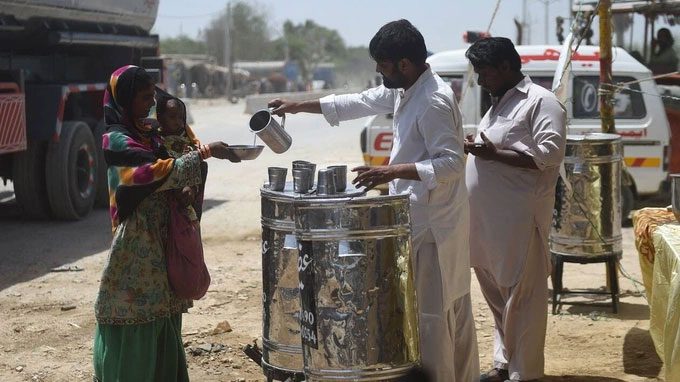Scientists Sound Alarm for Humanity’s Survival by the End of This Century.
Currently, about 30% of the world’s population is facing deadly heat waves for 20 days or more each year.
Scientists indicate that today’s heat resembles a rapidly spreading wildfire, fueled by climate change which is accelerating the distribution of this intense heat.
Research warns that if the Earth does not significantly reduce greenhouse gas emissions, particularly carbon dioxide (CO2), then by 2100, three out of four people worldwide will be at risk of dying from heat exposure.
Another study published in the journal Nature Climate Change reveals another alarming statistic: one in every two people globally is likely to experience lethal heat exposure for at least 20 days a year by the end of this century.

Scientists warn that heat may soon make India and Pakistan uninhabitable. (Illustrative photo: Ouest France).
Notably, this issue will persist even if greenhouse gas emissions are drastically reduced. The study serves as a warning to humanity that we must learn to adapt to the rising temperatures on our planet.
The lead author of the study, Professor Camilo Mora from the University of Hawaii (USA), stated: “Heat waves are becoming more common on the planet, yet our society does not pay much attention to the severe consequences they have for people in the present and the future.”
In the past, during the summer of 2003 in Europe, a major heat wave struck countries in the region, resulting in 70,000 deaths. This death toll is more than 20 times the number of fatalities from the terrorist attacks on September 11, 2001, in the United States.
Just last May, both India and Pakistan reported dozens of deaths due to heat, with record temperatures reaching 53.3 degrees Celsius. The United States has also seen cases of heat-related deaths during the summer.
Alarming Figures
The research reveals that individuals living in humid tropical regions face a higher risk of death when average temperatures or humidity levels rise slightly.
“In particular, heat can be lethal even when temperatures are below 30 degrees Celsius, as long as they are combined with very high humidity,” explained Professor Camilo Mora.
According to Professor Richard Keller from the University of Wisconsin (USA), heat-related deaths in the United States are ten times higher than those caused by tornadoes or other natural disasters.
Children and the elderly are the most vulnerable groups as they often lack supportive resources and face greater social isolation.
Richard Keller noted that during the European heat wave in 2003, the vast majority of those who died in the heat in France were aged 75 and older, living alone.
Furthermore, the increase in global average temperatures leads to rising social inequalities, resulting in higher death rates during heat peaks.
Which Regions Will Be Affected?
Although heat is not considered a major issue in India, Pakistan, and southern countries, unprecedented heat waves are becoming more frequent and severe in these areas due to climate change.
In recent years, thousands have died from heat waves in India.
A recent study published in the journal Science Advances revealed that heat waves have increased the death toll in India by 2.5 times compared to the period from 1960 to 2009.
Steven Davis, the study’s author and a professor at the University of California (USA), stated that this increase is attributed to climate change.
However, the average temperature in India has only risen by 0.5 degrees Celsius over the past 50 years, a smaller increase compared to other regions globally.
Surface air temperature measurements indicate that global warming has reached 1 degree Celsius since the pre-industrial era, but this increase is not evenly distributed.
In particular, the Arctic is experiencing an average increase of 2.5 degrees Celsius, and in November 2016, a significant portion of the Arctic recorded a record increase of 20 degrees Celsius.
Steven Davis pointed out that even slight increases in average temperatures can have significant consequences in tropical countries, especially for the extremely vulnerable poor.
“In Chicago (USA), people can escape the heat, but this is not the case for many poor individuals in India,” Davis explained.
According to him, this reflects the real-world impacts of climate change, and it is no surprise that there are about 60 lethal heat waves each year, with rising temperatures forcing people to leave their homes and migrate.
Professor Camilo Mora concluded: “Heat waves are often categorized from ‘worst’ to ‘less bad,’ and many people around the world are paying the price for our failure to protect the environment, leading to a harmed planet.”




















































